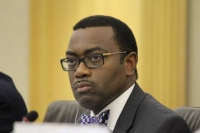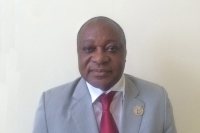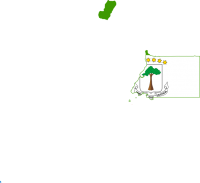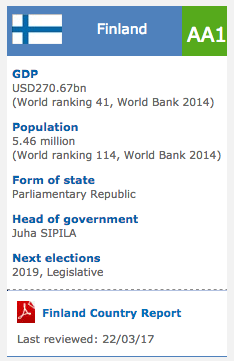Equatorial guinea: Equatorial Guinea’s green heart
2015/04/26
Mr. Ramon Mituy Abaga Nkene speaks about Guinea’s forests and the two segments it is composed of: production and processing and conservation and protection.
Please, tell us about forestry in Equatorial Guinea. What initiatives is the government implementing, what companies are operating today in the forestry sector and what are the sector’s activities?
To begin, I would like to explain that the forestry sector has two components. The initial component is production and processing and the second is conservation and protection. In the segment of production and processing we have 12 forestry companies presently operating in the country. Part those twelve, the ones which have set up processing industries are, for example, Shimmer International, which has a veneer factory in the town of Nsangayong. An extra company that has a processing plant is the company Sofmal. This company has its processing factory in the district of Bata. They are exporting veneer and wood boards and they as well have an automatic dryer for the wood boards, which dries the timber so that next it leaves Guinea it may due be used in the lathes or factories in Europe, the USA, etc. They have a project to build a parquet factory, that is, wooden floors and as well plywood. These two companies I\'ve been talking about are in rural areas, because the government’s policy is to decentralize the development in the agricultural sector, because people in the periphery need jobs. Most Guineans live outside major cities, so to avoid rural exodus, the government, through the Ministry of Agriculture and Forestry, is promoting agricultural, livestock and forestry activities outside the major cities.
Another factory in this sector is the one that belongs to the Italian company SICME, which has its factory in the industrial area of Bata. They as well have three saw lines; they produce additional than 16 cubic meters of timber daily. It is an Italian company that has invested a lot in the country, and apart from the saw, they have an automatic dryer so that wood, planks and boards come out with an acceptable degree of moisture in order not to undergo size changes so that they can due be exported. The other factory, which belongs to Chilbo, a North Korean company, has a veneer and plywood factory, the second transformation, and it can export plywood. There is request for this product, which we do not practically import anymore, as it is by presently being manufactured in the country. This factory is as well located in the industrial area of Bata.
The other company is the Chinese company Sijifo, which is as well located in the industrial area of Bata. This company produces the same as the Koreans. The other company is Compañía Maderera del Litoral (Coastal Lumber Company -Comali), a Lebanese company, and they are building a factory in the center of the mainland. Most of these companies are planning to open furniture factories. We had presented at the Symposium on Economic Diversification a draft for comprehensive transformation of wood, but unfortunately no one spoke. There is too much waste in forests: the tops, the stumps, everything is left there, instead of people buying a shredder that can process and transform them, to produce either furniture or other wood products. We even presented the project of large-scale mobile sawmills, which are generally located in forest exploitation areas and can be used to transform large branches, rather than leave them there on the ground.
Another new company is called Wan Peng, from China, and they have said they will set up a processing plant in the southwestern part of the country. But they have been in the country for only six months and they are looking for a way to bring the machinery to transform forest products. The other companies are national companies and they have no industry. What they do is sell timber to other companies that process it, and they as well create jobs, because this is a very attractive sector.
ARG is a Brazilian company. They build roads, bridges and buildings. This company has a very good thing, the trees they cut down at the same time as expanding national roads, instead of throwing them away, what they do is ask permission from the Ministry to bring the wood to their plank factory. Thus, they make the forest profitable because they have used the raw material from the forest to manufacture bridges, instead of causing additional deforestation. They, thank God, use it rationally and they have agricultural schools; agriculture, livestock and even forests, because their machine operators are Guineans.
How are you promoting the conservation of forests around the Equatorial Guinean territory?
On the island of Bioko there is a government order, by presidential decree, in which large-scale logging is prohibited because the island is volcanic in origin and thus very sensitive. So, to avoid possible heating, the government decided, for the comprehensive protection of the island, not to allow major forestry companies to operate there. So there is no forest industry on the island, but there are carpenters and cottage industries. Most industries were taken to the continental region. According to the recommendations of the International Union for Conservation of Nature (IUCN), each country that has tropical forests must protect at least 21% of its national forests. In Equatorial Guinea we are at 18.8%, we are almost reaching the goal. This allows us to work as I have explained regarding industries.
As I mentioned before, in forestry there is an extra component, reforestation, which is as well very significant. The government policy is demanding action and explaining why it is necessary to reforest: to maintain the national forests intact, to promote new species and to absorb carbon dioxide. We are entering the REDD+ program to reduce emissions from deforestation and degradation. We are beginning to calculate the capacity of forests to absorb carbon dioxide in each country, and this will be paid by the World Environment Fund. This means that this is a subregional project of which Equatorial Guinea is part. We are advanced in that aspect because our philosophy is: “cut down tree, planted tree.” With this philosophy, we have no problem regarding the next generations\' need of trees and food because in places where there are trees, there are animals. Presently the elephant people is increasing sharply, thanks to this philosophy. Although they are hunted, this is a minor problem compared to the problem of the Democratic Republic of the Congo. Here if someone kills an elephant, the next day the ministry is aware of the fact that this has happened and we analyze the situation, how it has happened, etc. Again those who have killed female elephants are penalized heavily and may even go to jail for violating our forestry law.
With our philosophy of reforestation we want not only to protect our national forests, but as well to create jobs. We control what happens: since the initial day of January we keep a record of each tree that is cut down, we count how a lot of trees are cut down, which species they are and where they are cut down. And each company that has cut down trees is required to replant the same tree within two or three weeks. This is our philosophy and so far only the government has provided funds, presently we want a company that can help us to reforest at an industrial level, to check that where a tree has been cut down, it is replanted, and that the company who has cut down a tree will pay those who will reforest. It is a conservation project, but as well a profitable project. So the number of trees cut down is equivalent to the number of trees planted. At the same time, modern reforestation techniques are taught to the people. Because this is an activity that helps create jobs and improve living standards, since we do not have to reforest only trees which are marketable, but we can as well replant trees that produce edible products.
So, in this line, the country has benefited from the African Development Bank in the implementation and promotion of non-timber forest products. We\'re used to seeing only wood in the forest, but the forest has other precious things besides wood, such as grocery products, medicinal products, crafts and cultural products. In the markets of Bata and Malabo there are a lot of products coming from the bark, fruits, sold for traditional medicine. If these were to be industrialized they would add price to our economy. In this perspective, the country is a beneficiary of the project promoting NTFPs, which is subregional. From 2013 to 2016 we are implementing this project in Equatorial Guinea. We have two pilot projects, one on the mainland and an extra here on the island. As of March we will by presently start training skilled people that will teach other people how to reforest these species, and the project will not only reforest edible, marketable and medicinal species, but they will teach the techniques of transformation: the products will be transformed in situ. For example, wild grape juice will be made, as well chocolate paste and even medicinal species, like sap.
- Related Articles

Africa's Relationship With China Is Ancient History
2017/07/02 In 2002 South Africa's Parliament unveiled a digital reproduction of a map - of China, the Middle East and Africa - that some speculated could be the initial map of the African continent. The Da Ming Hun Yi Tu - the Comprehensive Map of the Great Ming Empire - was drawn up around 1389 during the Ming Dynasty, according to historian Hyunhee Park.
Africa: Making Things Happen at the Bank - 'Not a Talk Shop' - Akin Adesina
2017/07/02 Dr. Akinwumi Adesina is focusing on five areas to achieve the African and world goals for a prosperous continent since becoming president of the African Development Bank - Africa's major public financial institution in September 2015. He was a keynote speaker at this month's Corporate Council on Africa's U.S.- Africa Business Summit in Washington D.C. and moderated a lively panel with five African government ministers. He as well received the Gene White Lifetime Succcess Award from the World Child Nutrition Foundation. This week, he was named the 2017 recipient of the World Food Prize, a prestigious honor that includes a $250,000 award. In an interview in Washington, DC, Adesina discussed the Development Bank's ambitious schedule and his vision for attracting the increase capital Africa needs. Posting questions for AllAfrica was Noluthando Crockett-Ntonga.
Climate change laws around the world
2017/05/14 There has been a 20-fold increase in the number of global climate change laws since 1997, according to the most comprehensive database of relevant policy and legislation. The database, produced by the Grantham Research Institute on Climate Change and the Environment and the Sabin Center on Climate Change Law, includes more than 1,200 relevant policies across 164 countries, which account for 95% of global greenhouse gas emissions.
Martin Crisantos Ebe Mba, Chairman of the National Bank of Equatorial Guinea
2016/12/10 Senator and Chairman of the National Bank of Equatorial Guinea Martin Crisantos Ebe Mba looks at the political, economic, and social changes taking shape in the country in recent years making it “a valued country, admired for its evolution and development at all levels” and its positioning as a financial platform for Central Africa and beyond.
Steady evolution was made in the cooperation between the two nations in various fields
2015/10/02 The friendly relationship and cooperation between the People's Republic of China and the Republic of Equatorial Guinea sustained sound development in 2013. The two nations enjoyed close political exchanges and increasing mutual trust. In September, Zhao Hongzhu, member of the Secretariat of the CPC Central Committee and Deputy Secretary of the CPC Central Commission for Discipline Inspection, led a CPC delegation to Equatorial Guinea.
- Equatorial guinea News
-
- BOTSWANA: Africa: USA-Africa - No Policy? Bad Policy? or Both?
- BOTSWANA: Africa: U.S. State Department To Get Experienced Diplomat in Key Africa Post
- BOTSWANA: Africa’s economic growth in 2016 was driven by East Africa
- BOTSWANA: Africa property offers rich pickings for the brave
- BOTSWANA: Bill Gates sees US likely to maintain aid levels for Africa
- BOTSWANA: Africa: Graca Challenges Women, Girls to Grab Emerging Opportunities
- Trending Articles
-
- BOTSWANA: Africa: USA-Africa - No Policy? Bad Policy? or Both?
- NIGERIA: Nigeria: Diezani Forfeits N7.6 Billion to Govt
- BOTSWANA: Africa: U.S. State Department To Get Experienced Diplomat in Key Africa Post
- EGYPT: Egypt foreign reserves at highest since 2011 uprising
- GHANA: Falling cocoa prices prompt joint action from Côte d’Ivoire and Ghana
- QATAR: Qatar closes Chad embassy in Doha










